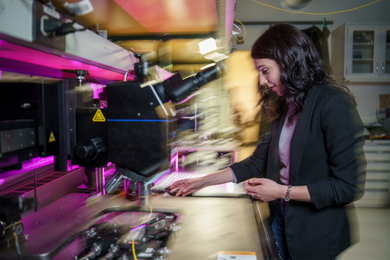MIT is a primary partner in a new statewide program designed to improve the teaching of mathematics and science in public schools. The program was recently funded with a $10 million grant from the National Science Foundation.
The program, called Project PALMS (Partnerships Advancing Learning of Mathematics and Science), is a five-year initiative that "will create the first-ever statewide mathematics and science education policy and curriculum framework for all Massachusetts schools," according to a Massachusetts Department of Education press release announcing the NSF grant.
MIT and Northeastern University are primary partners in Project PALMS with the Massachusetts Department of Education. Susan Zelman, associate commissioner at the Department of Education, is principal investigator; Professor Michael Silevitch of Northeastern and Professor Ronald M. Latanision of MIT are co-principal investigators.
Professor Latanision, head of the MIT Council on Primary and Secondary Education, stresses that "this is a real partnership. The fact that Mike Silevitch and I are co-PIs is not just symbolism, it's a real collaboration between the state and the two institutions of higher education."
He notes that MIT and Northeastern helped construct the Project PALMS proposal sent to the NSF, and that MIT President Charles M. Vest and Northeastern President John A. Curry have played important roles.
As a further example of collaborations between the partners, Professor Latanision points to "Imagine That!," a science literacy series to be broadcast by WHDH-TV beginning May 31. The idea for Imagine That! actually grew out of a conversation between MIT President Charles M. Vest and WHDH general manager Bruce Marson.
"The idea fit beautifully into the agenda for the MIT Council on Primary and Secondary Education," he explained, but further, the partners in Project PALMS "all thought collectively that such a series would fit well with the Project PALMS proposal."
According to a Department of Education press release, the four major goals of Project PALMS are to:
- ������Improve mathematics and science curriculum and assessment methods used in elementary schools, high schools and adult learning centers.
- ������Provide extensive professional development opportunities in mathematics and science for teachers and administrators.
- ������Improve the way prospective math and science teachers are prepared.
- ������Create and expand partnerships among schools, colleges, businesses, cultural organizations, parents, retired citizens, and other segments of the community to help students learn math and science.
Professor Latanision said that MIT will continue to be actively involved in Project PALMS. To that end, four members of the MIT community are on the steering committee of Project PALMS. They are Paul E. Gray, chairman of the MIT Corporation; Susan Carey, a professor in brain and cognitive sciences; Judah L. Schwartz, a professor in the School of Engineering; and Gregory A. Jackson, director of academic computing.
Such involvement, Professor Latanision said, "represents a real commitment by MIT to primary and secondary education."
Finally, Professor Latanision noted that a large fraction of the $10 million awarded to Project PALMS will go directly to the support of teachers involved in PALMS initiatives. "While some programmatic funds may flow to MIT," he said, "the grant is really meant to stimulate systemic change in teaching math and science. Clearly the teachers are key to such change."
A version of this article appeared in the May 20, 1992 issue of MIT Tech Talk (Volume 36, Number 31).





